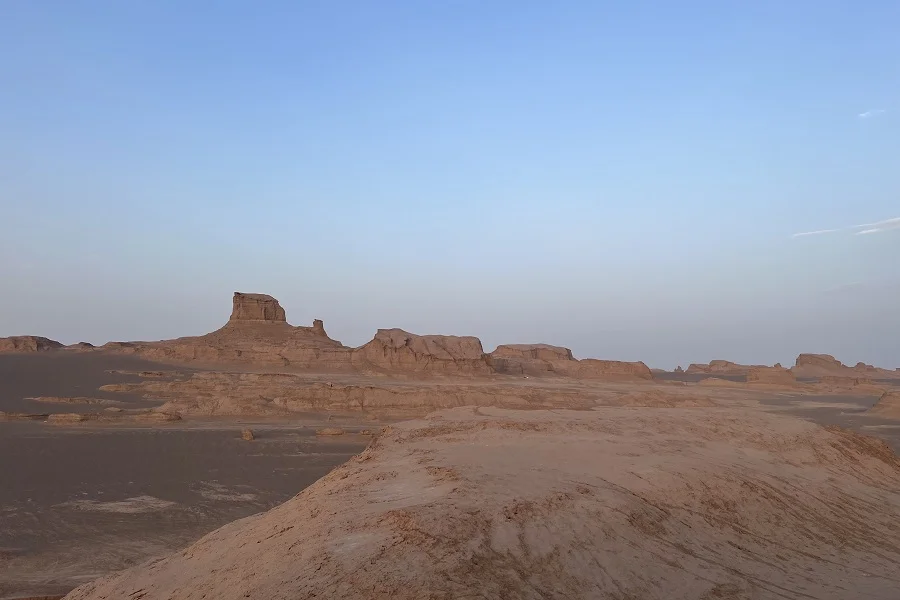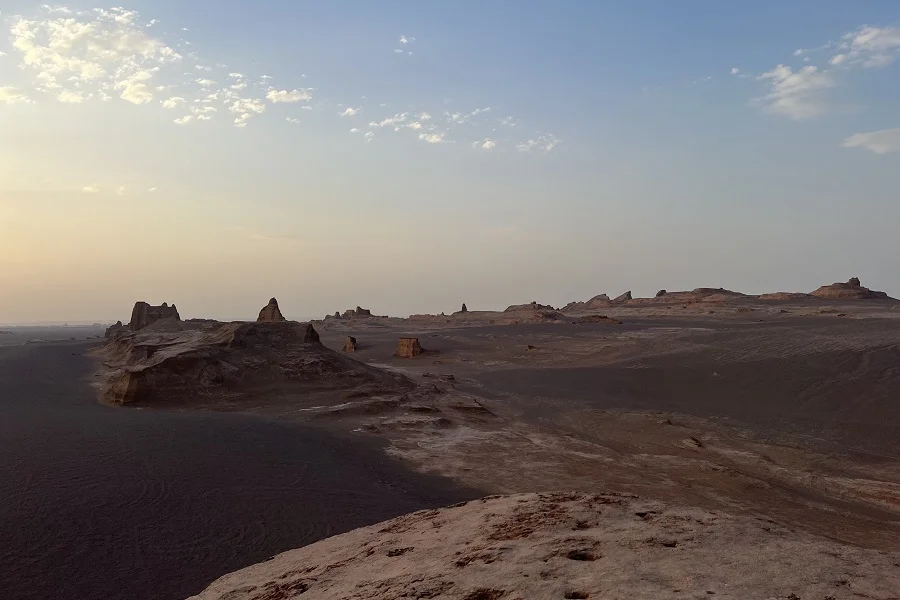
Exploring the Wonders of Lut Desert
Lut, meaning “plain, bare, waterless, and grassless,” perfectly describes the Lut Desert in southeast Iran. Spanning 175,000 square kilometers, it covers one-tenth of the country’s land area, stretching across South Khorasan, Sistan and Baluchestan, and Kerman provinces. Interestingly, the name “Lut Desert” can be misleading, as experts point out that the desert is only part of this vast region, which is more accurately referred to as the Lut Plain (Dasht-e Lut). Recognized for its natural significance, it became Iran’s first natural site to be listed as a UNESCO World Heritage.
Lut Desert: The Hottest Place on the Planet!
Have you ever wondered where the hottest place on Earth is? It’s in Iran, right in the Lut Desert, where temperatures reached a staggering 71°C in 2009, recorded by satellites. The desert’s black, iron-rich surface absorbs and holds heat, making it incredibly hot. Experts say the hottest point is the Central Lute Hole, located 75 kilometers east of Shahdad city.
Exploring the Geography of the Lut Desert
The Lut Desert is comprised of three distinct geographical regions.
Northern Lut
Northern Lut, also known as “Khorasan Lut,” is situated in Khorasan Province. This part of the Lut Plain is characterized by its gravel and pebble terrain. The southern edge of the region is bordered by the Rud Shur river, located near Birjand city. The name “Rud Shur” translates to “salty river,” and it lives up to its name as one of the saltiest rivers in the world, flowing for 200 kilometers through the desert’s salty landscape.
Interestingly, Northern Lut also features both sedimentary and volcanic mountains, which can occasionally trigger earthquakes in the area.
Central Lut
Central Lut, also known as “Chaleh Lut,” stretches 162 kilometers in length and 52 kilometers in width. This striking region is renowned for its stunning landscapes, featuring expansive sand dunes alongside scattered salt and gypsum deserts. Chaleh Lut’s unique beauty makes it a remarkable part of the Lut Desert in Iran.
South Lut
South Lut boasts the richest vegetation and signs of civilization within the Lut Plain. Most of this area is situated in Kerman Province, while a smaller portion extends into the northern part of Sistan and Baluchestan Province. This combination of lush plant life and historical remnants makes South Lut a unique and vibrant region in the desert.

Unique Geomorphological Features of the Lut Desert
The Lut Desert is home to three remarkably quirky geological structures that are worth exploring.
Cobbled Area of Dasht-e Sar
The Cobbled Area of Dasht-e Sar resembles a skillfully paved landscape, scattered with both small and large stones, which is why it’s often referred to as the “paving desert.” This unique terrain has been shaped by factors such as wind erosion, river flows, and extreme temperature variations, resulting in its distinctive, vegetation-free appearance.
Kaluts
“Kalut” is a local term that refers to deep ditches and massive sand pyramids, making it a unique natural phenomenon. These stunning structures have been formed over 20,000 years through the erosive forces of wind and water. The wind carries sand particles that smooth the surfaces of the Kaluts, while the Rud Shur river dissolves the softer components in its salty waters.
Additionally, a strong 120-day wind from Sistan plays a crucial role in shaping the Kaluts and regulating the temperature between day and night.
Sand Dunes
In Central Lut, an impressive expanse of 50,000 hectares is home to magnificent sand dunes that soar up to 500 meters in height, showcasing the grandeur of this unique desert landscape.
Nebka
Nebka refers to the round sand dunes that can reach heights of up to 10 meters, where tamarisk trees and shrubs thrive. Often described as the “vases of the desert,” these unique formations are among the remarkable features of the Lut Desert. For comparison, the Nebkas found in the Sahara Desert typically rise only to about 3 meters.
Mysteries of the Lut Desert
Throughout history, people have spun eerie tales around the unknown, and the Lut Desert is no exception. Its harsh conditions make it difficult to explore deep into the desert, leaving many mysteries waiting to be uncovered. As a result, locals have created numerous captivating stories that reflect the intrigue surrounding this enigmatic landscape.
The Lut Desert’s People
Nestled in the heart of the desert, near Shahdad city, lies a civilization that dates back 6,000 years. This area is home to the world’s oldest iron flag, discovered in the ancient cemetery of Shahdad, alongside numerous pottery pieces and statues. Remarkable finds also include dinosaur nail fossils and fragments of meteorites.
Some believe that the ancient civilization remnants in this region belong to the Lot people, with the name “Lut” thought to be a transformation of “Lot.” According to ancient tales, the Lot people were turned to stone and buried beneath mudstones.

Shahdad Kaluts: The Enigmatic City of Illusions
One of the most breathtaking features of the Lut Desert is the striking Kaluts in Shahdad. As the longest sand structures in the world, they resemble a skyline of skyscrapers from a distance. This enchanting landscape has inspired various names, including “City of Ghosts,” “Imaginary City,” and “Lut City.”
Spanning 11,000 square kilometers, the Shahdad Kaluts remain a source of curiosity and intrigue. Despite the belief that no life exists among these breathtaking formations, no one has fully explored the entire area. In 1986, a peculiar discovery was made—a dead cow that had been there for 15 years, yet remarkably, its body showed no signs of decay. Experts suggest that the extreme heat caused the body to dry out, while the salty environment halted the decomposition process.
One of the most fascinating aspects of the Shahdad Kaluts is that they contain the deepest point of the Iranian Plateau, which lies 56 meters above sea level, right within this enigmatic desert.
Shahdad Lake
Despite the Lut Desert being known as one of the toughest environments in the world, it may surprise you to learn that there are flowing rivers in the area. In fact, several can be found, especially along the desert’s edges. The remnants of dried-up riverbanks serve as evidence that once, many large rivers flowed through this landscape. It’s likely that these rivers still see some activity during the rainy seasons today.
Several rivers descend from the Kerman mountains into this plain, maintaining lush greenery throughout the year and keeping the surrounding ground moist. Recent seasonal rains have given rise to a stunning lake, characterized by its breathtaking beauty.
Vegetation of the Lut Desert
The vegetation in the Lut Plain primarily consists of tamarisk trees and shrubs that thrive on Nebkas. These resilient plants draw sustenance from underground water sources, enabling them to survive in the arid environment.
Animal Species of the Lut Desert
The Lut Plain is home to a variety of animal species, including Rüppell’s fox, sand cats, rabbits, arrow snakes, and both golden and black scorpions, among others. This diverse wildlife has adapted to thrive in the harsh desert environment.
Conclusion
While the Dasht-e Lut may lack extensive tourist facilities, its unique allure attracts many visitors. Beyond its breathtaking natural beauty, you can embark on thrilling adventures such as safaris, motorcycling, camel riding, and stargazing at night.
Nearby attractions worth exploring include Shafiabad Castle, the Shahdad water reservoir, Shahzadeh Garden, and the historical Arg-e Bam, which is a bit further away.
I hope you enjoyed reading this article. If you have any questions or are interested in visiting the Lut Desert and Shahdad Kaluts, our expert guides are here to assist you.

